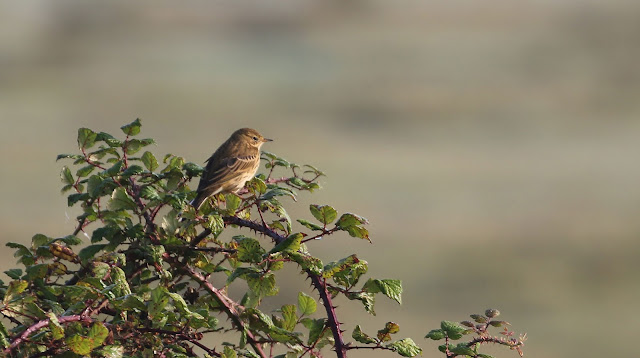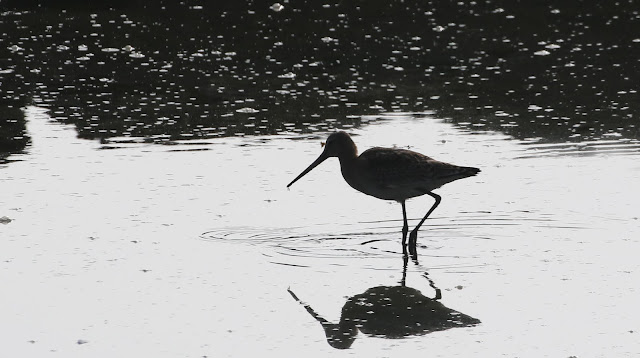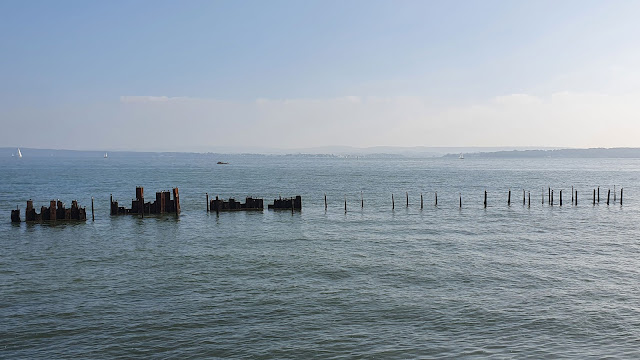At the start of the week there was a report of a possible Semipalmated Sandpiper on Normandy Marsh that could possibly be a Western Sandpiper, due to the length of the bill, the reports through the week were rather few and far between,probably due to the difficulty of getting close photographs, then finally on Wednesday the news broke of confirmation that this was indeed the first reported Western Sandpiper, identified from some better photographs and more viewers in the field.
So it was then that twelve months to the day after another rarity had been reported at Keyhaven - Lymington Reserve, the Wilson's Phalarope, I met Ian about an hour before sun rise in the Lower Pennington Lane car park to ensure we had a parking space. Fortunately it was a beautiful morning, with that lovely orange glow in the sky away to the west. We decided that there was no point rushing over the Normandy Marsh. It was currently low tide, so we set off across the old tip towards Fishtail Lagoon.
As we approached the lagoon it was still murky, one Little Grebe chick remained, it seemed to be confused and was pestering a Coot. The adult though soon appeared and normal service was resumed. Out on the lagoon it was nice to see Wigeon in full plumage and pairs swimming across what was now becoming pink water with the sky changing colour once again.
Walking up on to the sea wall the tide status was confirmed it was a very low tide with Butts Bay almost completely drained.
A Sparrowhawk flew low over the lagoon and then disappeared into the bushes, probably in search of the small birds just waking up. This was the first of three seen, another closer to Keyhaven and one more along the Ancient Highway.
A large group of Canada Geese were making a lot of noise on the lagoon, the calls normally associated with movement. Walking around to Keyhaven Lagoon the numbers of Canadas increased even more, and the still water provided some nice reflections as the geese made their presence known.
Finally groups of geese took off, flying low across the water and throwing reflections into the lagoon. In these circumstances I feel that black and white images do much more justice to the spectacle as they flew across the lagoon..
With the Canada Geese all but gone a lone drake Wigeon was left on the water close to the sea wall.
On the other side of the sea wall the mud was fully exposed and still covered in the green sea weed. Pretty soon this will die off and the winter tides will just reveal the grey brown mud, but today with the pink hue from the surrounding sky reflecting in the narrow channel that meandered its way through the mud, it framed the hunting Little Egret nicely.
Officially the sun had been up for about 5 minutes, but due to the low cloud had not been visible, looking west now though it could be made out as it started to break through the low mist.
Slowly it rose and became a complete ball, the intensity reduced by the surrounding mist which gave us the opportunity to see a distinctive sun spot.
Believe me this is a spot on the sun, officially sunspot AR2882. This sunspot is believed to be associated with a solar flare which is a flash of increased brightness.. A sunspot is an area on the sun's surface with a reduced temperature, which is why it appears darker.
Flares are also associated with coronal mass ejection (CME) which is a significant release of plasma and magnetic fields from the solar corona, the aura of plasma that surrounds the sun, the area most notably visible during an eclipse.
This CME was expected to hit the earth on the 11th October and with it possible disruption to power grids and the possibility of seeing the northern lights in more southerly locations. The CME did hit the earth but without a lot of inconvenience, the sunspot is now decaying reducing the chance of anymore flares.
What the sun did provide this morning though was some wonderful views as it rose slowly in the sky and lit up the surrounding clouds through the mist, while small groups of probably Wigeon flew past.
A very distant Marsh Harrier flew past us heading west.
We decided to walk around to Keyhaven harbour and to take a look across the Pans. With the tide still out the water levels were low allowing this Little Egret to hunt quite close in.
A Swan gracefully swam through the still mirror like water before turning around and flying back out!
Leaving the hide on the Pans there was a beautiful scene across the harbour, the sun now having broken through the mist.
Chiffchaffs called from the pines along the highway, but remained out of sight. What were visible though were the thousands of spider webs that covered the gorse bulrushes and bramble, an incredible sight only brought into view by the low sun reflecting on the heavy dew that was caught on the webs and silk spun overnight.
The orb spider at the centre of her web.
An early rising Red Admiral taking in the sunshine on one of the fence posts.
There was quite a bit of activity along the highway, with many Meadow Pipits flying over calling and several settling along the fence wires and in the surrounding bushes.
There were also a good number of Stonechat, again showing well on the bramble, interestingly all were males.
This individual finding a high point to catch the morning sunshine
I finally managed to catch one of the Chiffchaffs feeding in the ditch.
Then as we approached the car park, three Stonechat perched in a bush.
After a short break for a cup of tea we set off once again, a message had come in to say that the Sandpiper had been seen but we decided to play it cool and take our time walking to Normandy.
We walked down to Fishtail pausing to check the pools at the back of the lagoon. Here we found three Greenshank and a single Ruff.
Here the Ruff appeared to be picking either spiders or insects off the webs in the bulrush.
On the pool by the sea wall, once again where the young Little Grebe was showing well, looking almost adult like now.
But still dependent on a parent for food.
Interestingly the youngster dropped the fish and the adult was not able to recover it!
In better light I took the opportunity to photograph the Wigeon, it is great to have their whistles and beautiful plumage colours back.
The tide was now returning to Butts bay and out on the rocks were several waders, amongst the Grey Plover were six Bar-tailed Godwits. This year has been a good one for Bar-tailed Godwit sightings.
Scanning the marsh behind the bay produced a Peregrine sitting on a small post, well hidden amongst the vegetation.
Off shore this drake Eider has not quite yet acquired the full male breeding plumage.
The walk from there was uneventful aside from the incredible number of Canada Geese that came across the Solent to swell the number present on the lagoons, numbers must have been in excess of 500
On the mud in Oxey creek were a couple of Black-tailed Godwits, they were completely un-phased by the now increased number of walkers on the sea wall.
With the sun still low I decided to walk around the wall and see what the silhouettes looked like against the mud and water. For once these are not black and white images, but the silhouettes work for me very well.
We finally reached Normandy Marsh where there was a good number of birders already present, telescopes pointing towards the islands in the middle of the marsh from the west and south sides of the sea wall.
Interest was on a small roost of Dunlin, but going through them there was no sign of anything smaller or stint like.
There was a moment when one of the waders looked a little interesting and I managed to get quite a few into the debate, but eventually as it moved closer to the Dunlin roost it was clear that it was a Dunlin.
We continued the wait and more Dunlin flew onto the lagoon from the tidal mud where the water was rising steadily.
A search of the new comers did not find anything of interest.
We moved to the south side of the lagoon with the sun behind us, here it was possible to sit down, which was a relief. I picked up a small wader that looked like a stint, but considered it a Little Stint as the bill did not seem to be as pronounced as that seen on the images posted so far. Eventually it flew across the lagoon and disappeared behind the island in front of us.
Then one of the birds close by asked if we had seen it, they said this was the bird, we were not so certain and hoped it would appear, which eventually it did, coming along the shore of the island on the left hand side.
In this light we could see the rufous colour on the scapulars and with a closer look at the bill we both agreed this was longer than what we would expect on a Little Stint. The head also appears much lighter with a defined supercillium. As the bird turned the rufous orange patches on the back became much clearer.
The bird has been identified as an adult, based on the rufous, but as the bird goes into non breeding plumage this diminishes and is replaced with grey plumage above. The juvenile, immature bird does have rufous in the plumage. What was evident was the white forehead face on and the lack of streaking on the breast, the bill is droopy, but seen against the Dunlin's very different in size.
Like many sandpiper species, Western Sandpiper females have
longer bills than males and are generally larger. In the populations of Western
Sandpipers that winter farthest south, females outnumber males, while the
reverse is true in the northern parts of the winter range.
I managed to get a few digiscoped shots.
Believe me it was much better watching through the scope a long awaited lifer and I was very pleased to see it. Western Sandpipers nest mostly in Alaska and migrate mostly
along the Pacific Coast, but many reach the North American Atlantic Coast in autumn and remain
through the winter. They are not know for long flights across water, which is probably one of the reasons why this is one of the rarest of the North American "peeps" to be found in the Western Palearctic.
In migration, the Western Sandpiper stages the journey in huge,
spectacular flocks, particularly along the Pacific coast at San Francisco Bay
and in the Copper River Delta in Alaska. Estimates suggest that nearly the
whole breeding population passes through the Copper River Delta during just a
few weeks each spring.
Many of the Western Sandpipers that winter in Central
America remain there for the first summer of their lives, rather than migrating
north to breed. By contrast, birds of the same age that winter in the United
States or Mexico usually attempt to return to the breeding grounds in their
first spring.
Western Sandpipers compete with many other sandpiper species
when foraging. When larger Dunlin are absent, Western Sandpipers forage at the
edge of the receding or advancing tide, where prey is easiest to catch. When
Dunlin are present, Westerns often forage on drier areas of mud. This bird seemed to be comfortable around the Dunlin, although it spent much of its time foraging away from them.
Eventually it went behind the island once again, our stomach's were rumbling so we decided to move on. Ideally we would have liked a better shot, but it would seem the behaviour we had experienced today was pretty much the way it has been over the last few days. So we decided to move on.
We walked back around Oxey Marsh where the little Egrets posed yet more photo opportunities.
And like the lone Wigeon earlier in the day I was taken by the single Black-headed Gull sitting amongst the expanse of still reflective water.
With the tide high every available perch on the old jetty iron works was taken by a Turnstone. Safer here than on the jetty wall itself as there were too many dogs about.
After a late lunch we set off along the Ancient Highway, more in hope that anything definite. One feature of the day was the number of Red Admiral that we saw, mostly flying past us and over the bramble.
A stop to scan the tip produced a distant Marsh Harrier, it was looking to gain some height circling around over the tip and eventually coming close enough to photograph.
A little further along we disturbed a buck Roe Deer.
It was now a very warm October afternoon, t-shirts were the order of the day and there were plenty of people about. We never expect much from these afternoon walks and so far there hadn't been much about to trouble the cameras. Then we noticed a couple standing watch an area of gorse, and one struggling with a field guide. It turned out they were looking at a Wheatear at the base of the gorse ( I had wished for a Wryneck!).
In the corner of Keyhaven Lagoon another Little Egret became another photographic opportunity with some more reflections.
A movement of Swallows had become noticeable with plenty of them streaming over the sea wall and heading out across the saltmarsh and beyond to the Isle of Wight. But many were also taking the opportunity to bathe and drink in the freshwater of the lagoon before crossing the sea and this produced a flurry of activity not dissimilar to taht we witnessed at Farlington in the spring when the swallows were arriving. All these birds looked like juveniles, lacking the tail streamers of the adults. Incredible to think that these birds only recently hatched were embarking on such a journey.
A dunk in the water
A shake an move on.
I think this was an attempt to drink, but it missed the water.
As we watched the Swallows and attempted to capture their antics a Wheatear, probably the same bird we had seen earlier appeared below us.
It then kindly flew off and sat in one of the small bushes close to the lagoon.
On reaching Fishtail, there were plenty of duck at the back of the water, including the first Pintail of the day. A group of what we though to be Teal originally were flying around the lagoon to the back, but on closer inspection turned out to be a group of ten Golden Plover. After several circuits they came back to settle amongst the grasses
.
As is usually the case with Golden Plover here they did not settle for long and were soon off again flying around. These were the first of the autumn / winter and before we know it a flock the size of 300 birds will be wheeling over here and Pennington Marsh.
Ian then picked up what must be one of the surprises of the day, a Goshawk over Efford Lake that was upsetting the Starlings, it moved away to the west and out of sight.
As we started to walk back to the car a small flock of Brent Geese flew in and landed on the lagoon, a timely reminder that despite the warm and sunny conditions, winter was not that far away and very soon the numbers of Brent Geese will be seriously outnumbering any of the other geese around the reserve.
Interestingly as we walked away we were asked why the Brent Goose is called "Brent". There is always a smart question to be had and we couldn't answer it, I knew the Brent oil field was named after the geese but not why they are Brent. So a little bit of research and I have the answer.
The goose is sometimes called Brant or Brent and this comes from a Latinsed form of the Old Norse word brandgas which means "burnt" (black) goose. So there is an interesting fact to go along with the origins of how the sniper got its name while spending time in a hide.
A very successful day that was blessed with good weather.


















































































No comments:
Post a Comment